

Elfin Miniature Creeping Thyme, is also known as Thymus serpyllum 'Elfin'
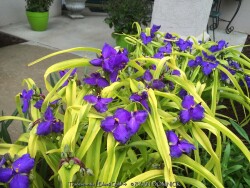

Blue & Gold Spiderwort, is also known as Tradescantia x andersoniana 'Blue and Gold'


Native Rose Verbena / Glandularia, is also known as Verbena / Glandularia canadensis
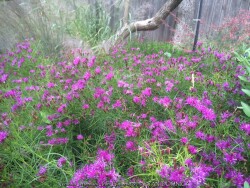

Narrow-leaf Ironweed (Vernonia lettermannii) is a relatively new plant to horticulture; originally discovered in Arkansas along gravel stream beds in the wild. The Iron Butterfly cultivar (Vernonia lettermannii 'Iron Butterfly') is a dwarf compact cultivar introduced by Dr. Allan Armitage at the University of Georgia. This is a true four-seasons perennial that belongs in almost every perennial garden. In the spring, narrow dark green foliage resembling Amsonia hubrichtii creates a compact shrub-like appearance. The growth is so dense that no weeds have a chance of invading a mature stand of plants. By mid to late summer, gorgeous deep purple fine-textured flowers cover the plant for 4-6 weeks. Butterflies, bees, and other pollinators flock to the occasion. Following the bloom, the flower stocks are sturdy and hold up very well for fall and winter interest. The flowers themselves produce mostly non-viable seed and cling to the plant creating a silvery shine whenever sunlight hits it. This can be very useful and dried flower arrangements as well as winter interest gardens. At some point in the winter, all top growth will need to be cut back as this is the only maintenance required. Despite being native to gravel and sand bars along rivers, Iron butterfly Vernonia surprisingly can handle very dry clay, gravelly, or sandy soils along with short periods of flooding. Permanently wet soil is not favored but it can handle the upper portions of a rain garden. Iron butterfly has only one pest problem and that is rabbits! If rabbits are an issue, just put a bowl-shaped chicken wire cage around the plants for the first year. By year #2, the rapidly growing foliage will outgrow any detrimental rabbit browsing. This is definitely one of the most adapted landscape plants in Kansas zone 6a with no problems with heat or cold, dry or wet! It's hard to imagine a perennial garden without this plant!
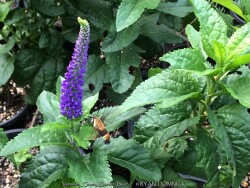

Sunny Border Blue Veronica, is also known as Veronica 'Sunny Border Blue'


>>>>>Decker Prague Evergreen Viburnum (Viburnum pragense 'Decker') is a hybrid between leatherleaf viburnum and €â€â‚¬â€â‚¬â€â‚¬â€â‚¬â€-The key difference is that Prague viburnum is slightly faster growing and more consistent reliable evergreen foliage. Foliage is more of a green color during the winter and very glossy. Craig viburnum has more narrow denser foliage. It can be easily pruned into a green wall or large hedge for screening.
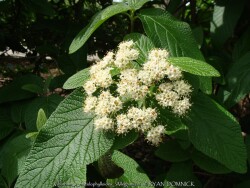

Leatherleaf viburnum is a large semi-evergreen shrub with leathery leaves and cream white flowers. Foliage emerges light green with powdery white material on the backside of the leaf. Foliage darkens to a medium green by summer and finally turning to a purplish winter color. About half of the foliage drops in the winter but is still effective enough for a partial screening. Flowers bloom mostly in spring but sporadically throughout the year. If pollination occurs, red fruits follow in the late summer thru fall creating quite a show. More than one variety is typically required for pollination. Leatherleaf viburnum prefers medium to rich garden soil in full to part sun. Being one of the toughest viburnums around, it can handle much less than ideal conditions including dry shade. Typically our are 40 inches of rainfall per year in eastern Kansas is enough without extra water. However, during times of drought, the foliage will wilt and growth will stop. Luckily the foliage is able to survive in a wilted state for a long time (usually up to two or three weeks) before actually dying. This gives you plenty of notice that it needs water. There is virtually no maintenance except rejuvenation on very old plants. Yearly fertilizer application is appreciated. When given plenty of room to grow, Leatherleaf Viburnum can reach up to 8 or 12 feet tall and wide after 20-30 years. Eventually old canes become unproductive and should be removed allowing young vigorous canes to develop. Leatherleaf viburnum grows slow at first especially in rough soils but the key thing is that it will survive and grow faster when established. Cold hardiness is not a problem in Lawrence Kansas zone 6a but in colder climates expect winterkill down to the ground in some years. Considered one of the best plants for solving your most difficult dry-shade landscape challenges. Several improved cultivars exist. Alleghany Leatherleaf Viburnum (Viburnum x rhytidophylloides 'Alleghany') has improved cold hardiness and growth form.
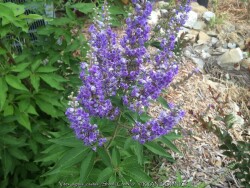

>>>>>In Eastern Kansas, this cultivar performs WELL with just about everything nature has to challenge it! Extreme heat and drought are tolerated. Cold tolerance is no problem in our zone 6. If winter die-back occurs, cut back in March/April and flowers will occur on new growth this year. No disease or pest problems. Great plant for berms, hot West or South exposures, and most any other garden situations in full sun. Will tolerate clay soils and extra moisture in summer. Combine with caryopteris, crapemyrtle, and butterflybush to create a late season "all you can eat" buffet for pollinators!
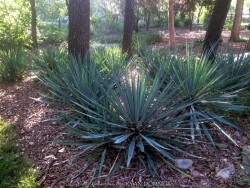

Adam's Needle Yucca (Yucca filamentosa) is a slow-growing broadleaf evergreen perennial. Blue-green leaves form rosettes about 2-3 feet tall and wide. Tall white flower spikes reliably appear on mature plants in May and June. If pollination is successful, attractive seed heads form later turning to black before cracking open. Although yuccas are more typical of western deserts and grasslands, this one is native to central and eastern United States. Tough as nails, yuccas are the ideal plant for a no-maintenance garden. Normally a plant has specific requirements for success but Adam's needle yucca has only one: it cannot tolerate growing in standing water or really wet soil. Plant in full sun to dry shade in any soil! In the landscape yuccas are often seen planted alone by a mailbox or neglected old landscape because they have outlived the original owners and the landscape service life. The root system of decades old plants may take up the underground volume of a large trash can. Yuccas look best when combined with other flowering plants providing texture and color. In mass plantings, yucca can create an interesting architectural look. Combined with ornamental grasses, yuccas can create stunning contrasts with winter grass colors of pink, orange and rust. Yucca flowers are pollinated exclusively by the yucca moth and deserve a place in native plant and pollinator gardens. This is a true 4-season "Once it's there, it's there forever" plant! Considered one of the best plants for solving your most difficult dry-shade landscape challenges.
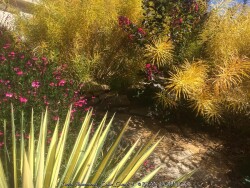

Adam's needle yucca (Yucca filamentosa) is a slow-growing broadleaf evergreen perennial. Blue-green leaves form rosettes about 2-3 feet tall and wide. Tall white flower spikes reliably appear on mature plants in May and June. If pollination is successful, attractive seed heads form later turning to black before cracking open. Although yuccas are more typical of western deserts and grasslands, this one is native to central and eastern United States. Tough as nails, yuccas are the ideal plant for a no-maintenance garden. Normally a plant has specific requirements for success but Adam's needle yucca has only one: it cannot tolerate growing in standing water or really wet soil. Plant in full sun to dry shade in any soil! In the landscape yuccas are often seen planted alone by a mailbox or neglected old landscape because they have outlived the original owners and the landscape service life. The root system of decades old plants may take up the underground volume of a large trash can. Yuccas look best when combined with other flowering plants providing texture and color. In mass plantings, yucca can create an interesting architectural look. Combined with ornamental grasses, yuccas can create stunning contrasts with winter grass colors of pink, orange and rust. Yucca flowers are pollinated exclusively by the yucca moth and deserve a place in native plant and pollinator gardens. This is a true 4-season "Once it's there, it's there forever" plant! Color Guard Yucca (Yucca filamentosa 'Color Guard') is a beautiful variegated variety with a bright yellow stripe down the middle of the leaf. The yellow color turns pinkish red with full winter sun and cold temperatures creating a stunning effect. Landscape designers often count on this variety for winter color!
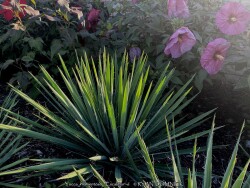

Adam's Needle Yucca (Yucca filamentosa) is a slow-growing broadleaf evergreen perennial. Blue-green leaves form rosettes about 2-3 feet tall and wide. Tall white flower spikes reliably appear on mature plants in May and June. If pollination is successful, attractive seed heads form later turning to black before cracking open. Although yuccas are more typical of western deserts and grasslands, this one is native to central and eastern United States. Tough as nails, yuccas are the ideal plant for a no-maintenance garden. Normally a plant has specific requirements for success but Adam's needle yucca has only one: it cannot tolerate growing in standing water or really wet soil. Plant in full sun to dry shade in any soil! In the landscape yuccas are often seen planted alone by a mailbox or neglected old landscape because they have outlived the original owners and the landscape service life. The root system of decades old plants may take up the underground volume of a large trash can. Yuccas look best when combined with other flowering plants providing texture and color. In mass plantings, yucca can create an interesting architectural look. Combined with ornamental grasses, yuccas can create stunning contrasts with winter grass colors of pink, orange and rust. Yucca flowers are pollinated exclusively by the yucca moth and deserve a place in native plant and pollinator gardens. This is a true 4-season "Once it's there, it's there forever" plant! 'Excalibur' is a beautiful compact bluish variety with lots of attractive curly white filaments on the edge of the leaves.